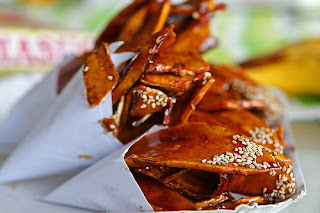Built in 1910, Roca Encantanda offers a striking view of the beach from its balcony or porch.
Isla Naburot, Guimaras Island
Guimaras was formerly called Himal-us and was a sub-province of Iloilo until 1992 when they gained their independence.
It was believed by the archaeologists and geologists that Guimaras was once part of Panay Island. Both islands were of the same age.
The province is located southeast of Panay Island and northwest of Negros Island. It has an area of 60, 465 hectares and a population of 162, 943 as of 2010. The capital is Jordan. It has 98 barangays divided by 5 municipalities namely, Buenavista, Jordan, Nueva Valencia, San Lorenzo and Sibunag.
The island of Guimaras is near the port of Iloilo and is accessible through pump boats and can be reached within 15 - 20 minutes. It has wonderful shorelines, stunning waterfalls, springs, caves and remote islands that is so attractive for island hopping.
Dr. Jose Rizal mentioned Guimaras in his diary as early as 1890 about travels as a pleasing picnic island. He wrote this entry in his diary: "Near Iloilo, there is an island which was ideally made a picnic venue for families."
The island is a gift of nature that provides protection and refuge has a bright promising potential as a tourist destination. Since the beginning, Guimaras is already an ideal place for relaxation ideal for fishing, skiing and diving, shell collecting, butterfly catching and other forms of outdoor recreation.
"Guimaras is therapeutic" written by Dean C. Worcester, professor of zoology at the University of Michigan. The professor went on a vacation in the island in 1887. He said "In the month of our stay in Salag Dako, not only we regain our health and wellness but we also obtain important materials."
Aside from having the great potential of being a tourist attraction, Guimaras is rich in natural resources. A large portion of citrus fruits sustain Iloilo province, almost half of its copra, big portion of sea foods. It has a large deposit of steel, silica, clay, lime and other minerals. It is home to one of the sweetest mangoes in the world along with several towns in Iloilo since they produce the most number of mangoes in the country.
American forces learned the importance of Guimaras. They assigned two cavalry regiments whose influence and effect is commemorated by the barrios which bear American names such as Montpelier, Maclaine coral street in Supang, aligning point in Punta Blanco, the dockyard in Barangay Santo Rosario, Buenavista built by then Lieutenant Douglas MacArthur of the United States Corps of Engineering in 1903. It is also in the wilderness of Guimaras in Buenavista where the life of Douglas MacArthur were in danger when he was attacked by the desperate brigands. Fortunately, his life was spared when a bullet hit his hat. This crucial part of his life was documented by MacArthur in his "Reminiscences or Memories."
Naburot Island is a 2.5 hectare coral isle in the western shores of Guimaras, white sand, rich in colorful coral and marine life
Bala-an Bukid (Sacred Mountain) - on top of Bundolan Point which has a giant cross and chapel, flocked by Catholic pilgrims during the Holy Week, offers a breath taking view of Iloilo City across the Iloilo strait and it is about 30 minutes walk from the chief port of Jordan.
Trappist Monastery, Barangay San Miguel, Jordan - considered as the first and only Trappist monk monastery in the Philippines. Offers tranquility, peace and relaxation to those who are tired and weary to offer some time for prayers and meditation.
Catilaran Cave - 20 kilometers south of Jordan, 1/2 kilometers of cave and about an hour jeepney ride from the port of Jordan; used as a refuge and shelter of the ancient people before the Spaniard arrived.
Three Isles in Jordan - about 45 minutes boat ride from Iloilo City; small caves; ideal for swimming, camping, boating; white sands
Rumagangrang - about 45 kilometers from Jordan port; white sand beach, caves, crystal blue waters, rich marine life
Puting Balas (White Sand) - 20 minutes boat ride from Jordan port; perfect for picnic; nearby mountains invites everyone who wants to climb.
Biri Cave - 1 1/2 kilometer from Barangay Poblacion; 45 minutes walk from small river and steep pathway; narrow entry spacious very cool interior
Ambakan Cave - natural falls with crystal clear water, perfect for swimming, camping and walking tours.
Macopo Falls - 12 kilometers from the Jordan port; beautiful waterfalls with two (2) crystal clear water pool for swimming
Beautiful Jordan and Buenavista Municipal Halls
Beach of Tiniguiban Red Shrimp in Nueva Valencia is found at the western tip of Tiniguiban Isle, white sand, ideal for picnic, swimming and scuba diving; red shrimps that belongs to a unique species is abundant in the nearby small lake and only comes out of hiding when there's a surge in water level.
Alubihod Beach in Nueva Valencia - beach resort perfect for swimming, picnic because of its white sand; 30 minutes jeep or car ride from the town center or about an hour and a half pump boat ride from Iloilo City

























